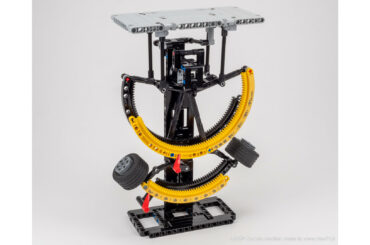A simple GBC (Great Ball Contraption) module to know the speed of a line of GBB.
This module was developed for the coming soon exhibition at Diemoz (France) in September 2015. The idea is, when it is placed in the GBC line, to know the speed of this line. Not the exact speed because it is impossible without sensor but the tendency of the speed, between min (no ball travelling), and max (every possible ball picked up by the module).
The functioning is based on a differential, which measures the difference between the angular position of two systems. Theses two system are, the motorized conveyor, and the 6-ends wheels. One planetary gear of the differential is connected to the conveyor, the other planetary is connected to the 6-ends wheels. The main gear of the differential is then connected to the sliding indicator mechanism on the top. In order that if one planetary gear moves, the position of the cursor which indicates the speed changes too.
When there is no ball on conveyor, the 6-ends wheel don’t rotate, and the conveyor make the planetary gear turns which makes rotate the differential and tends to move the cursor to the Min position. But when there are some balls, the balls push the 6-ends wheel and make it rotate. Then, it makes rotate the differential in other way which tends to move the cursor to the Max position. The internal gearing has been chosen in order to make the cursor moves faster to the Max position instead of min. Thanks to this, without balls, the cursor moves slightly to the Min, but with ball, it moves slightly in other direction (because it makes more rotate its planetary gear than the conveyor planetary).
The module is also equipped of a rotating agitator for reliability convenience and can handle 1 ball / sec of a batch of 15 balls.




(7) Comments
Yes in dead, as I write in the article “Not the exact speed because it is impossible without sensor but the tendency of the speed, between min (no ball travelling), and max (every possible ball picked up by the module).” The idea is that the max represents the necessary speed of the GBC line which is balanced to 1 ball every second. Therefore, if there are more than 1 ball / sec, the cursor gets stuck in the max, and if there are less, the cursor decrease to the min. Send me your Lego proposal when it is ready.
The current averaging mechanism has a problem : if the ball turnstile spins continuously even slightly more than 50% of the time (or respectively below 50%), the display will end up saturating to the maximum (or respectively to the minimum) without stabilizing itself between.
A fix (which costs a lot of room however) would be to make the decay’s speed proportional to the hand’s position (the closest to zero, the slowest), thanks to a CVT mechanism, in order to emulate the “decreasing exponential” behaviour of electronical R-C circuits (1st-order low-pass filters).
As a consequence, at zero ball rate, the hand slowly stops at “Minimum” = “Zero” ; at max ball rate, the decay’s speed is at its maximum, thus cancelling the turnstile’s speed, and preventing the hand from moving beyond “Maximum”. And at last, any intermediate rate results in an intermediate hand’s position.
I’m currently working on a different implementation, but which is based on the same principle.
why is there no building instructions or part list for the GBC speedometer how can I build one if there is no building instructions AS I WANT TO USE IT FOR MY MARBLE RUN
If there is not ball inserted, the cursor goes to min, and when it has reached it can not moves, but the system is not locked because I have placed a linear clutch. You can see this linear clutch on the picture in red. Regards
Very imppressive.
I don’t unserstand what will happen when long time no ball is inserted. The speedometer will be on Min and it will try to be lower but the chain can’t move any more.
Will the 6 end wheel turn to the opposite side?
On the opposite case, if the speedometer is on Max for long time and the chain can’t move more. Will the GBC go slowly?
No philo, the green color is good because for a GBC, the aim is to have speed, not empty module for viewing convenience, that is why I have chosen the green color for maximum speed 🙂
Beautiful – and clever as usual 😉
The only thing that mildly annoys me is the color of the dial: speed is generally associated with danger and red color, not green. Anyone who nursed a GBC loop will know what I mean 😉
Comments are closed.